Beak Trimming
Beak Trimming
Beak trimming is the removal of part of the top and bottom beak of a bird. It is also called “debeaking”, although this term is inaccurate as only part of the beak is removed. It is an animal husbandry practice commonly carried out in the poultry industry. Farm managers have their flocks beak-trimmed to blunt the beaks enough to prevent the occurrence of damaging pecking. Re-trimming may also be carried out if a bird’s beak grows back enough to cause pecking damage. Birds are often re-trimmed at 8–12 weeks of age to avoid this happening. Some non-trimmed adult birds may need trimming if a pecking outbreak occurs.
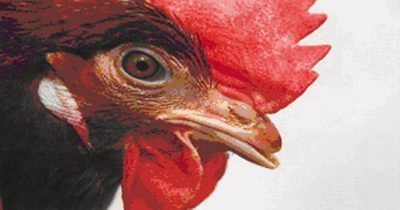
A beak trimmed bird
Why is beak trimming done?
Beak trimming is performed early in the life of commercial hens to decrease injuries caused by cannibalism, bullying, and feather and vent pecking. Birds naturally peck at the environment and each other to investigate and work out where they fit into the flock (pecking order). This behaviour can become a problem in commercial situations and many deaths have been recorded among untrimmed hens. Feather pecking and cannibalism affects all birds in all production systems. When laying birds are kept in systems that give the opportunity for aggressive birds to contact many other birds, cannibalism and feather pecking can spread rapidly through the flock and result in injuries and mortality. Mortality of up to 25–30% of the flock can occur and cause huge mortality and morbidity problems as well as financial losses to the farmer.
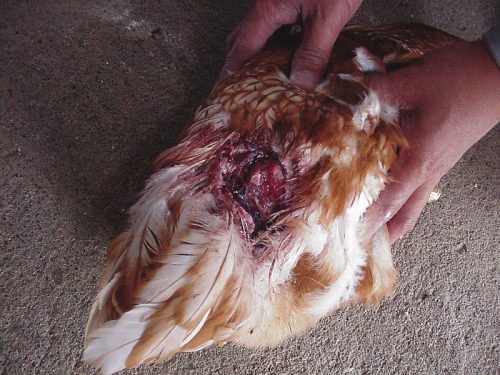
Bird seriously injured through pecking
When is beak trimming done?
Beak trimming is carried out at various ages depending on the preference of the farm manager. The most common ages for birds to be beak-trimmed are:
- Day-old (most common)
- 5–10 days old
- 4–6 weeks
- 8–12 weeks
- Touch up trim of adult birds (mainly in alternative systems)
Who does beak trimming?
Hot blade beak trimming is performed by contract teams, individual farmers and some large poultry companies. The majority of birds are trimmed by contract teams. Birds must be beak-trimmed by an accredited beak-trimmer to ensure that nationally agreed standards are maintained and the welfare of the birds is not compromised. The infrared treatment machine is installed by the supplier and leased by hatcheries. It is monitored and controlled by the supplier via a communication system and on-site computer.
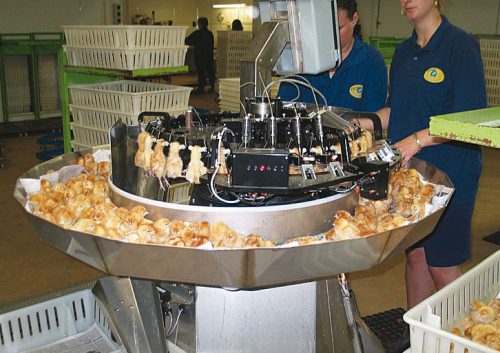
Infrared beak trimming machine
How is beak trimming done?
An infrared beak trimming method, using a non-contact, high intensity, infrared energy source to treat the beak tissue, is the most common method now in use. Initially, the beak surface remains intact but after a few weeks, the sharp hook of the beak erodes. Experiments have also been conducted using lasers for beak trimming, however, this technology is not used for beak trimming on farms. A hot blade beak trimming machine, with an electrically heated blade, is another method that has been commonly used in the past, now being surpassed by infrared.
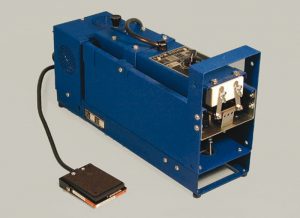
Hot blade beak trimming versus infrared beak treatment
|
|
Hot blade beak trimming |
Infrared beak treatment |
||
|
|
Advantages |
Disadvantage |
Advantages |
Disadvantages |
Biosecurity |
Beak trimmers move from farm to farm-potential biosecurity issues with personal hygiene and equipment cleanliness. | Equipment located in a clean hatchery. Staff maintain high levels of biosecurity. | ||
Bird catching |
Birds can be stressed from catching and restraint on the farm. | |||
Equipment set up |
Different set up for equipment when beak trimming different ages of bird, shed type or location. | Equipment located in the hatchery. | Settings adjusted easily using a keypad on the processor | |
Trimming |
Experienced operators can judge the amount of beak to remove. Accurate beak trimming minimises problems later in bird’s life. | Physical damage to the birds while being handled for beak-trimming. Exposed cauterised wound. Potential for bleeding from the beak. Excessive beak trimming can impair beak function. Insufficient beak trimming results in beak regrowth. | A predetermined amount of beak tissue is exposed to a defined amount of infrared energy. The exposed tissues remain intact and there are no open wounds or blood loss. | Restrained by head on an automated carousel for 15 seconds. Excessive energy can damage soft tissues and impair beak function. Insufficient beak treatment results in beak regrowth and the need to re-trim. Dark pigmentation in the beak can lead to split beaks. |
| Retrimming | Birds can be re-trimmed at any age with the hot blade. | Re-trimming can only be performed with a hot blade. | ||
Quality of beak trimming |
Quality assurance checks on beaks have been documented in an accreditation program referred to in the Australian Code of practice for Domestic Poultry. | In-house quality assurance program developed. | Quality assurance program needs inclusion in the Australian Code of Practice for Domestic Poultry. | |
Records |
Records kept on beak trimming quality and bird performance. | Records kept on beak trimming quality and bird performance. | ||
Evaluation |
Beak trimmers and farmers evaluate the performance of birds after trimming. | In house records of beak treatment and bird performance. | ||
Summary |
Open wound, re-trimming commonly practised to control pecking. | No open wounds; more reliable treatment, beak condition superior. If beaks regrow re-trimming required with a hot blade to avert cannibalism. | ||
Alternatives to beak trimming
Beak trimming has been banned in some European countries and others are working towards banning the practice, following an EU welfare directive on the issue. In some production schemes, for example, ‘Freedom Food Eggs’ (UK), infrared beak treatment is permitted but not hot blade trimming. Even before the EU directive was released, research was being undertaken to identify practical, effective and affordable alternatives to beak trimming. Selective breeding strategies are underway to produce strains that are not cannibalistic. In addition, a number of nutritional, management and environmental strategies are being promoted as an alternative to beak trimming. The alternatives have some potential to be effective in various management situations, but there is no guarantee that cannibalism and feather pecking will be prevented.
Genetic Selection
There are large differences in feather pecking and mortality in strains indicating the potential for developing commercial strains that require less severe beak-trimming or no trimming at all. Selection for low mortality reduces the propensity of birds to develop feather pecking and cannibalism. Molecular technology has the potential for improving welfare by manipulating genes involved in the control of pecking behaviour.
Light control
Chickens have colour vision and different colours and light levels affect chicken behaviour. Green and blue light improves growth and lowers the age of sexual maturity, while red, orange and yellow light increases the age of sexual maturity and red and orange light increase egg production. Birds are calmer in blue light. For many years it was the practice to brood and rear chickens under red light to prevent cannibalism, based on the concept that red light makes it difficult for a potentially cannibalistic bird to see red blood vessels and blood on other birds. Currently, the most useful method to prevent feather pecking and cannibalism is to house birds under very dim white light. The birds cannot see each other well which is thought to reduce aggressive behaviour among them. This requires light proof shedding, however low light levels can cause eye abnormalities.
Use of devices to restricting vision and beak use
The use of spectacles (fitted to the nares of birds) controls feather pecking. It only allows birds to look to the side or down but not directly ahead. Spectacles can only be put on birds of pullet size or larger, cannot be used in cages and are easily dislodged. Red contact lenses have been used for layers as an alternative to beak-trimming. They cause eye irritation, eye infections, and abnormal behaviour and are not retained well. Bitting devices have been developed for use in game birds, which are held in place by lugs inserted in the nares. The use of fitted devices as a preventative measure against feather pecking is not permitted in many countries.
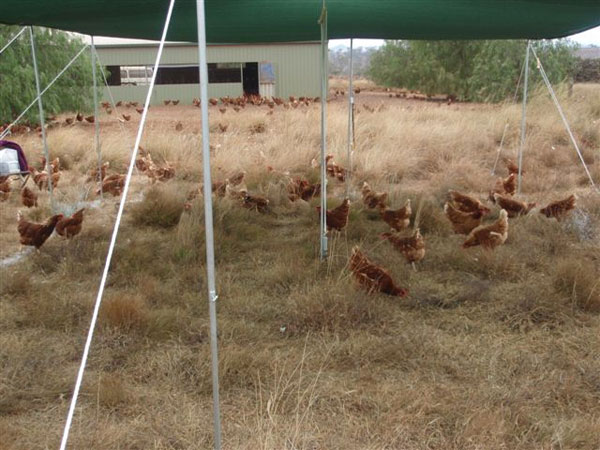
Using shade with free range flock
Environmental enrichment
Environmental enrichment aims to increase desirable behaviours, reduce harmful ones, sustain the birds’ long-term interest, and enable them to cope with challenges. Enrichment involves increasing environmental complexity to encourage birds to interact with their environment.
Practical enrichment devices to minimise feather pecking
A wide range of objects can be fitted to cages to enrich the environment for poultry. The ‘Agrotoy’ (blue plastic frame with red and blue moving parts) reduces aggression and mortality in caged layers. Likewise, a small silver bell was found to attract pecking. Cereal based ‘Peckablock’ also reduced the amount of aggressive behaviour. Adult laying hens will peck at bunches of plain white propylene string, which reduces both gentle and severe feather pecking.
Enriched rearing facility
Less feather pecking in layers is seen if farmers do their own rearing, provide sufficient perch space, adequate drinkers and provide high quality litter. Stimulating use of the range Infrequent and uneven use of the hen run is one of the main problems in all free range systems for laying hens. Birds do not feel safe in an open unroofed run area. When the range has cover, trees or hedges, birds are more evenly distributed and risk of feather pecking is reduced.
Use of anti-pick compounds
Applying anti-pick compounds (commercial anti-pick, pine tar or axle grease) to wounded areas reduces pecking. Likewise treating the everted vent of hens suffering vent trauma with a stock wound spray can prevent other birds pecking at the vent. Incidence of vent trauma can be reduced by raising flocks of birds with an even body weight. A range of predator scents and other agents are being considered for use as repellents against predators and may have application to prevent feather pecking in layers.
Nutrition
The main strategy to prevent feather pecking is to provide an adequate substrate. Substrate conditions during the rearing period affect the development of feather pecking. Use of scratch grain is recommended. During the rearing period, placing semi-solid milk blocks in the house, hanging green leafy vegetables and spreading grass clippings can prevent feather pecking. An adequate amount of insoluble fibre in the layer diet is important for minimising the outbreak of cannibalism in chickens. Millrun, oat hulls, rice hulls and lucerne meal are effective sources of fibre. The physical properties of the fibre modulate the function of the gizzard making the birds calmer. Providing adequate calcium, manganese, arginine, zinc, protein, sulphur amino acids (methionine and cysteine), trytophan, B group vitamins, thiamine and dietary electrolytes minimises pecking mortality.
Beak abrasives
Abrasive materials applied to the feed trough may enable the bird to blunt the hooked end of the beak while feeding and reduce the effectiveness of pecking. The beak blunting technique can be applied to growing pullets and during the laying period. Utilising the blunting procedure early in the rearing period may prevent the formation of the hooked end of the beak.
Summary
When birds are not beak trimmed, increased incidences of mortality and morbidity will occur due to cannibalism. Welfare problems associated with cannibalism can be devastating. When performed correctly to industry standards, beak trimming has advantages. These include reduced:
• Feather pecking
• Mortality
• Vent pecking and prolapse
• Bullying
• Stress on the bird
When beak trimming is not done correctly, birds can suffer from:
• Reduced ability to eat and drink
• Short and long term stress
• Reduced social status
There are production techniques which may reduce the need for beak trimming, although none of these can guarantee against an outbreak of damaging pecking and cannibalism. These techniques include:
• Light control
• Devices to restrict vision
• Devices to restrict beak use
• Environmental enrichment
• Anti-pick compounds
• Nutritional amendments
• Beak abrasives
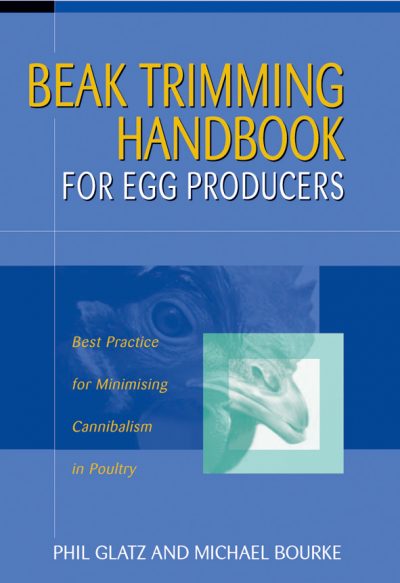
The Beak Trimming Handbook for Egg Producers: Best Practice for Minimising Cannibalism in Poultry has been published through CSIRO Publishing (ISBN: 0643092560). The Beak Trimming Handbook comprises eight chapters which highlight pecking problems and cannibalism, beak trimming methods, training and Codes of Practice, welfare issues and industry views on beak trimming.
Further information
- Bourke, M, Glatz, PC, Barnett, JL and Critchley, KL (2002) Beak-trimming training manual, Publication No 02/092, Rural Industries Research and Development Corporation, Kingston, Australia.
- Bourke, M, Glatz, PC, Barnett, JL and Critchley, KL (2002) Beak-trimming trainer’s guidelines, Publication No. 02/093, Rural Industries Research and Development Corporation, Kingston, Australia.
- Freire, R, Glatz PC and Hinch, G (2008) Self-administration of an analgesic does not alleviate pain in beak trimmed chickens. Asian-Aust J Anim Sci 21(3): 443-448.
- Glatz, PC (1987) Effect of beak-trimming and restraint on heart rate, food intake, body weight and egg production in hens. Br Poult Sci 28, 601.
- Glatz, PC (1990) Effect of age of beak-trimming on the production performance of hens. Aust J Exp Agr 30, 349.
- Glatz, PC, Murphy, LB and Preston, AP (1992) Analgesic therapy of beak-trimmed chickens. Aust Vet J 69, 18.
- Glatz, PC and Lunam, CA (1994) Production and heart rate responses of chickens beak-trimmed at hatch or at 10 or at 42 days of age. Aust J Exp Agr 34, 443.
- Glatz, PC (2000) Beak-trimming methods – a review. Asian-Aust J Anim Sci 13, 1619–37.
- Glatz, PC (ed) (2005) Poultry Welfare Issues – Beak-trimming, Nottingham University Press, Nottingham, UK.
- Jongman, EC, Glatz, PC and Barnett, JL (2008) Changes in behaviour of laying hens following beak trimming at hatch and re-trimming at 14 weeks. Asian-Aust J Anim Sci 21(2), 291-298.
- Lunam, CA, Glatz, PC and Hsu, Y-J (1996) The absence of neuromas in beaks of adult hens following conservative trimming at hatch. Aust Vet J 74(1), 1–5.
- Standing Committee of Agriculture and Resource Management (2004) Model Code of Practice for the Welfare of Animals, Domestic Poultry, CSIRO Publications, East Melbourne, Australia.

